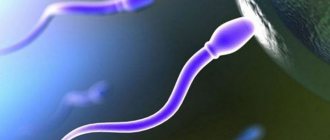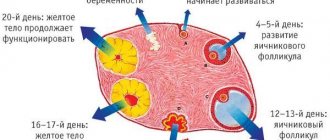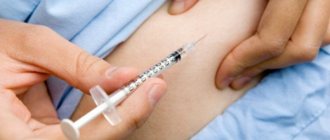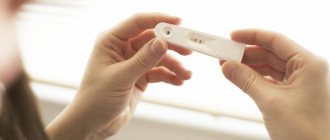The menstrual cycle alternates between periods when conception is most likely and when this probability tends to zero. Each representative of the fairer sex has individual characteristics of the frequency of critical days. Accordingly, conditionally safe days come at different times for each woman. When answering the question of how many days after menstruation you can not use protection, it is necessary to take a closer look at the frequency of the onset of the ovulation phase.
How to calculate
In order to find out how many days after menstruation you can not use protection, you need to perform simple mathematical calculations. It is necessary to divide the entire monthly period into two, then subtract two days from the result obtained. And if the cycle, for example, is twenty-six days, then the first eleven days, or from the fifteenth to the twenty-sixth day, can be considered the safest.
But you should always remember that the body can malfunction, and then no calculation of safe days after menstruation will help to avoid fertilization as a result of unprotected sexual intercourse. Read about the likelihood of getting pregnant on the last day of your period in material on similar topics.
This calculation is best used when pregnancy is just being planned. After all, an egg can leave the follicle at any time, and a certain number of sperm can live in a woman’s body for several days. Therefore, fertilization is possible during the time when monthly bleeding occurs.
How to determine ovulation yourself?
If a woman is observant, she can independently determine the time of ovulation by the color and consistency of cervical mucus.
If the discharge is abundant and transparent, and also resembles egg white, then, most likely, during this period the probability of fertilization is high. The role of these secretions is to facilitate the penetration of sperm into the female reproductive organ.
If the discharge has decreased and its consistency has become thicker, then the ovulation process is complete. But you should not rely on this sign, since very often the nature of the mucus secreted depends on the state of health of the female genital organs. Therefore, even if the result of this method indicates that ovulation has ended, it is still recommended to protect yourself from possible pregnancy using another method, for example, a barrier method.
You should always remember that natural methods of contraception are the least effective, and often many signs in the female body indicate the presence of certain abnormalities or diseases.
It is advisable to have unprotected sex with only one regular partner to avoid contracting sexually transmitted infections.
Favorable days before menstruation
Many women are of the opinion that the likelihood of pregnancy decreases in the first and last days of the menstrual cycle. That is, the safe days before menstruation are the last ten days.
This information is also not always reliable, since there may be several eggs in one month. And if two or more eggs are fertilized, then there is a possibility of multiple pregnancy.
If a woman’s menstruation always comes on time, and malfunctions are rarely observed in the body, then the first time of menstrual bleeding, approximately the first ten days, can be considered relatively safe. After all, it is clear that during this period there was no fertilization, and the new egg had not yet had time to mature. But even here there is no complete certainty; it is not recommended to rely completely on these calculations.
How to protect yourself in cycles
The safe period after menstruation is the period of time before and after expected ovulation. An exception is pathological processes affecting the ovulatory phase. For example, it can run up to 3 times in 1 cycle, or it may not occur at all. This is usually associated with diseases of the pelvic organs or deviations in their functionality.
To calculate dangerous and safe days, you need to know the duration of the cycle.
It is worth remembering that unprotected sex, even during a period of low probability of pregnancy, is not a 100% guarantee. It is worth protecting yourself throughout the entire cycle, and if one of the partners wishes, the girl can resort to medication. But this can affect her hormonal levels and endanger the body as a whole.
Days 13-17 in the menstrual cycle are the most dangerous for couples who are not planning a pregnancy. It is on these days that during a regular cycle the egg is expected to leave the follicle into the fallopian tubes.
To avoid conception, contraception must be constant
Advantages and disadvantages of natural contraception
The advantages of the calendar method of contraception are the following:
- no harmful effects on the body;
- knowledge of one’s own body, its vital functions;
- no side effect;
- material benefit, since there is no need for monetary costs.
But there are also significant disadvantages:
- ineffective in most cases;
- the fear of pregnancy does not disappear; there is no complete certainty that fertilization has not occurred;
- a natural method of contraception is not applicable if a woman has irregular periods;
- there is no protection against sexually transmitted infections.
Is it possible to conceive immediately after menstruation?
According to experts, the first 3 days after menstruation are considered safe, but do not forget about the facts indicating early ovulation. In this case, the maturation of the egg occurs just in the last days of menstruation and the chance of getting pregnant increases significantly. The reasons for the early ovulatory phase are:
- constant pressure;
- stress;
- emotional instability;
- genetic inheritance;
- gynecological diseases;
- incorrect medication course;
- STI;
- disturbance of sleep and activity patterns.
Other methods for identifying dangerous days
All women are recommended to mark the dates indicating the beginning and end of menstruation on a special calendar. Thus, it is possible to identify the approximate ovulation cycle and calculate how safe certain days of the menstrual period are.
But besides the calendar method for setting days on which you can have sex without fear of getting pregnant, there are other more effective ways to do this:
- method of measuring basal temperature;
- using an ovulation test;
- own feelings, well-being;
- hormonal method;
- determination of the color and thickness of cervical mucus.
The basal method involves measuring temperature by inserting a thermometer into the anus in the morning, preferably before getting out of bed in the morning. The results obtained must be noted in the form of a graph, and this procedure should be carried out for at least three months in a row.
Before ovulation, the rectal temperature is thirty-six degrees, and after it it is approximately thirty-seven degrees, sometimes a little higher.
As for ovulation tests, their principle of operation is similar to tests that determine the presence or absence of pregnancy. The difference lies only in the active substance of these devices. Ovulation tests need to be done every day for a certain period of time.
Another method that you can use, but you cannot rely on it completely, since it is listening to your own body, to your feelings. There are several signs indicating a favorable time for conception:
- decreased desire to have sex;
- a large amount of clear secretion released from the genital tract;
- pain in the lower abdomen.
If there are no changes in basal temperature, as well as with negative ovulation test results throughout the entire monthly cycle, the likelihood of pregnancy is significantly reduced.
What days are safe?
The first few days of bleeding are considered to be the beginning of the menstrual cycle. They generally last from 3 to 7 days, and the entire cycle lasts from 28 to 35 days. It all depends on the individual characteristics of the body.
The days of ovulation are the shortest phase in which the egg is released into the uterine cavity, and it is this that determines the dangerous and safe days.
A safe period is considered to be a certain period of time during which there is the least chance of getting pregnant. But these are conventions, since the female body is not predictable and the menstrual cycle depends on many factors that influence the duration of each phase. The general recommendations of gynecologists are protection at any time, since menstruation is irregular, and against the background of hormonal changes provoked by external reasons, the egg can be fertilized at any time.
However, experts note that safe days after and before menstruation are a time period of 2-4 days. But do not forget about gynecological diseases that can be sexually transmitted.
Chances of getting pregnant before your period
The method of contraception using a calendar will be ineffective even in cases where the probability of becoming pregnant is calculated before menstruation. This is explained by the same failures that can occur simultaneously. This development of events is far from uncommon. In addition, during the period of one cycle there is a risk of maturation of not one, but several eggs. In addition, sperm, once in the female body, can retain their viability for quite a long time. Taken together, all these factors significantly increase the likelihood of pregnancy.
Conception after menstruation
According to gynecologists, there are no absolutely safe days of the cycle. Medical practice has repeatedly proven that it is impossible to completely exclude the possibility of conception even after the end of menstruation. Not ready to replenish? Then the best way is protection. The fact is that the next ovulation is yet to come, and even the most experienced specialist cannot determine its timing. The ability to get pregnant after the end of the critical days depends on the properties of the body of a particular woman.
The degree of probability of fertilization of an egg at a certain point in time can vary from the very minimum values to almost one hundred percent probability. The likelihood of successful conception is influenced by many different factors, the main of which are:
- Life cycle of an egg (the maximum period of life of a female reproductive cell is one day).
- The lifespan of sperm in a partner (male reproductive cells can exist almost twice as long - from 48 to 72 hours).
A woman’s opportunity to become pregnant appears precisely during the ovulation period, which, according to medical literature, occurs in the middle of the entire cycle. If sperm enters the vagina before ovulation, the chances of conceiving a child increase significantly.
Can ovulation occur immediately after menstruation? Of course, the maturation of a new egg in the ovaries often begins at the end of menstruation. That is why, in the first days of the beginning of the cycle, the egg can already enter the abdominal cavity and meet the sperm. The possibility of such a development of events with early ovulation is not excluded. This can be triggered by various disruptions in the body's hormonal system. The most common causes of early ovulation include:
- Strong psycho-emotional shocks.
- Sleep problems (irregular sleep or insomnia).
- Diseases associated with the reproductive system.
- Infectious diseases that are sexually transmitted.
- Hereditary predisposition.
- Incorrect contraceptive regimen.
According to research, approximately one in five women who had unprotected sex after their period ended became pregnant. The list of factors influencing the likelihood of getting pregnant includes:
- Irregular cycle.
- Longer duration of menstruation (from a week or more).
- Early completion of the cycle (the duration of the entire period is less than three weeks).
- The appearance of bleeding not associated with menstruation (for example, during sexual intercourse or as a result of erosion). All this usually leads to incorrect calculation of the ovulation period.
Should you trust the method?
Safe periods in a woman’s cycle have always been considered 3-5 days before and after menstruation. But research proves the opposite fact. The fact is that it is impossible to be absolutely sure that sex is safe these days, since the onset of the ovular phase is influenced by many factors that do not always depend on the woman’s actions.
There are recorded cases where pregnancy occurred after intercourse during menstruation, since girls experienced an early stage of ovulation, in which the egg matured already in the last days of menstruation.
It is almost impossible to feel hormonal imbalances, so it is always necessary to take precautions. This will prevent unwanted pregnancy and many gynecological diseases that the partner may not be aware of.











